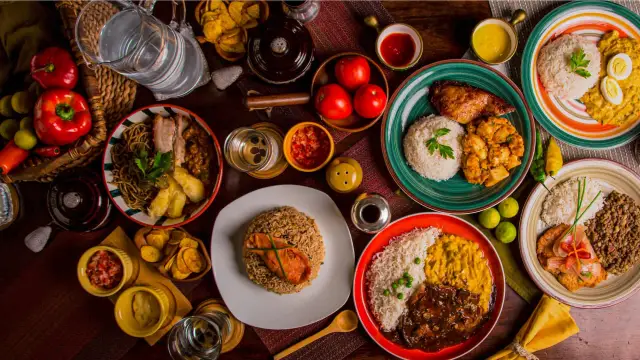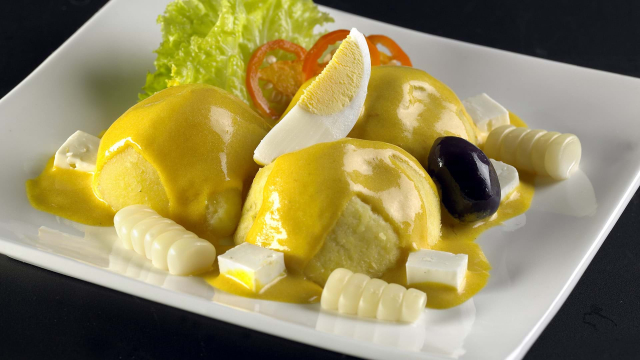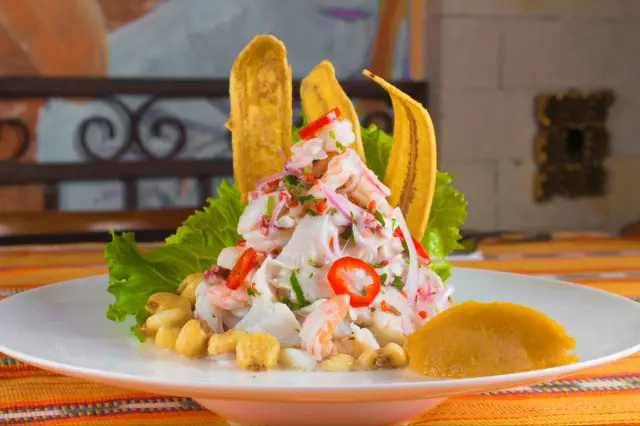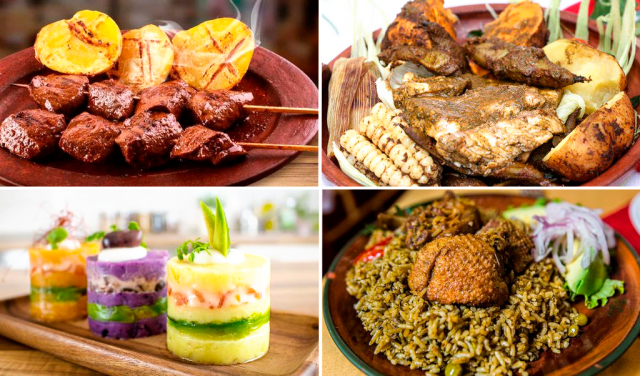The cuisine of Peru's Fiestas Patrias ( National Holidays) is much more than a culinary tradition: it's a profound reflection of the cultural identity of a country proud of its diversity. Every July 28th , in celebration of independence, thousands of homes and restaurants across the country prepare dishes that bring together centuries of history, a fusion of cultures, and local creativity. This date becomes an excellent opportunity to pay homage to the flavors that represent the coast, the mountains, and the jungle, fundamental pillars of Peruvian cuisine.
In addition to their culinary value, these dishes serve an important social function: bringing families together , reviving ancestral traditions , and strengthening ties between generations. From fresh ceviche evoking sea breezes to pachamanca, which connects us to the Andean earth, the Peruvian table on July 28th is as varied as it is delicious. Below, we'll explore the most popular traditional dishes and their most representative characteristics.

Typical Dishes of July 28 in Peru
1. Ceviche: The Pride of the Peruvian Coast
Peruvian ceviche is considered the country's signature dish. It consists of diced fresh fish (usually sea bass or sole) marinated in lemon juice, seasoned with salt, red onion, limo chili, and cilantro. Its citrus flavor, balanced by the spiciness and freshness of the ingredients, makes it an ideal starter to kick off any celebration.
During the Fiestas Patrias (National Holidays), it's common to find varied versions of ceviche, including options with seafood, octopus, or even mixed ingredients. Traditionally, it's accompanied with boiled sweet potato, shelled corn, and a lettuce leaf, which balances the dish in both texture and color. Its freshness and instant preparation are part of the charm that makes it a must-try on July 28th.
2. Anticuchos: A Street-to-Table Classic
Anticuchos have their roots in the colonial era and were originally prepared by African slaves with offal or less prized parts of cattle. Today, they are mostly made with beef heart, marinated in a mixture of red vinegar, garlic, cumin, and panca chili, and then grilled on skewers over charcoal.
This dish, traditionally served at fairs and festivals, has evolved to reach the country's finest restaurants, maintaining its popular essence. Anticucho is typically served with golden potatoes and a portion of chili sauce, which further enhances its distinctive flavor. Its simple yet tasty preparation makes it a favorite for July 28th barbecues.
3. Papa a la Huancaína: Simple but Unbeatable
Papa a la Huancaína is a cold appetizer that has earned a place on the table during national celebrations. Its name comes from the city of Huancayo, although its preparation has been standardized nationwide. It is made with boiled yellow potatoes covered in a creamy sauce made with fresh cheese, yellow chili pepper, milk, and crackers.
It's served on lettuce leaves, garnished with a hard-boiled egg and black olives. Despite its simplicity, its intense flavor and soft texture make it a must-have. Its easy preparation also makes it perfect for large family gatherings during the holidays.

4. Causa Limeña: Fresh and Colorful
Causa limeña is another national classic, especially popular along the coast. It consists of a pressed yellow potato dough, seasoned with yellow chili pepper and lemon juice, and filled with ingredients such as shredded chicken, tuna, seafood, or vegetables. It's a cold dish that combines flavor, freshness, and color in every bite.
One of its main virtues is its versatility: it can be adapted to vegetarian diets or combined with gourmet flavors to give it a modern touch. During the National Holidays, it's common to see it decorated with Peruvian flags, olives, and avocado, making it a visual and culinary delight.
5. Grilled Chicken: The Weekend Must-Have
Grilled chicken has become a national symbol in its own right. Although its official day is celebrated on the third Sunday in July, its presence on the table on July 28th is almost obligatory. It's marinated with spices, garlic, dark beer, and other homemade secrets, then slowly roasted until crispy skin and juicy meat are achieved.
Accompanied by golden fries and a fresh salad, this dish is one of the most popular in the country during the Fiestas Patrias (National Holidays). Whether served at traditional chicken restaurants or homemade, its popularity knows no boundaries or social class. Even Peruvians abroad seek to replicate it as a way to reconnect with their homeland.
6. Pachamanca: Andean Heritage
Pachamanca is one of the most ceremonial and ancient dishes in Peruvian cuisine. Its preparation involves cooking meats (beef, pork, chicken, and lamb) along with potatoes, sweet potatoes, beans, and corn, all buried under hot stones. This ancient technique, originating in Andean communities, represents a direct connection with the earth and ancestral spirituality.
On July 28th, many rural and urban communities organize collective pachamancas as part of their national celebrations. While not everyone can afford a traditional pit, there are modern versions adapted to the oven or pot, which maintain the essential ingredients and characteristic flavor of this Andean feast.

7. Duck Rice: A Northern Delight
Duck and rice is a symbol of northern Peru, especially the Lambayeque region. Its flavor is characterized by the use of cilantro, chicha de jora, and dark beer, which give it its distinctive green color and intense seasoning. The duck, previously browned and slowly cooked, provides a unique, juicy flavor.
This dish is often prepared in large quantities, making it ideal for family gatherings and parties. It's also highly appreciated for its combination of technique, flavor, and history. If you want to take the celebration to the next level, this is one of the dishes you should include on your July 28th table.
8. Mazamorra Morada and Rice Pudding: Iconic Desserts
The most representative desserts of Fiestas Patrias are undoubtedly rice pudding and mazamorra morada . The former is prepared with rice slowly cooked in milk, sugar, cinnamon, and cloves, until a creamy texture is achieved. The latter is made with purple corn, dried fruits, cinnamon, and chuño as a thickener.
Served together, they form the famous "classic," a pairing that's a must-have at the end of a patriotic meal. This dessert delights not only with its flavor but also with the nostalgia and tradition it represents for many Peruvian families.
Tips for Celebrating with Peruvian Flavor
Celebrating the National Holidays with an authentic Peruvian flavor doesn't require a huge budget, but it does require good planning and creativity. Here are some practical tips to make your July 28th table unforgettable:
Choose dishes in advance: Plan your menu ahead of time and consider options you can prepare in advance, such as papa a la huancaína or rice pudding.
Shop at local markets: Support local producers by purchasing fresh ingredients like chili peppers, native potatoes, and freshly caught fish.
Decorate with national symbols: Use red and white tablecloths, flags, flowers, and Creole music to set the mood for the celebration.
Involve the family: Cooking as a group is not only more efficient, it also strengthens family ties and passes on traditions to new generations.
Share on social media: Show off your patriotic table using hashtags like #FiestasPatrias, #CocinaPeruana, and #SaborNacional. Inspire others!
These small actions not only elevate your celebration, but also contribute to preserving and spreading the richness of Peruvian cuisine.

Frequently Asked Questions (FAQ)
What dishes should not be missing from the table on July 28th?
Ceviche, anticuchos, papa a la huancaína, causa limeña, and pollo a la brasa are the most representative. For dessert, mazamorra morada and rice pudding are a must.
Are there vegetarian alternatives to celebrate?
Yes, you can prepare vegetarian versions of many traditional dishes. For example, vegetable causa, mushroom or mango ceviche, and tofu or mushroom anticuchos. Peruvian cuisine is highly adaptable.
What traditional drinks are recommended to accompany it?
The most common are chicha morada, emoliente, and pisco sour. You can also offer Andean infusions such as muña or lemon verbena to round out the meal.
Where can I enjoy these dishes if I don't want to cook?
Restaurants specializing in Creole cuisine or gastronomic events for Fiestas Patrias are excellent options. Patriotic delivery services are also available in major cities like Lima, Arequipa, and Cusco.
What music is ideal for enjoying a meal?
Creole music is the best choice: waltzes, marineras, and festejos help create a festive and traditional atmosphere. You can find playlists on Spotify or YouTube specially curated for Fiestas Patrias.
Flavor, Tradition and National Pride
Celebrating July 28th with traditional Peruvian dishes is a delicious way to pay tribute to our history and culture. Every bite tells a story of fusion, resilience, and innovation. Whether you choose to prepare a traditional ceviche or a family pachamanca, the essential thing is to live the experience with love for our own. The National Holidays invite us to gather together, value our roots, and share the table with those we love most. Because in Peru, cuisine not only nourishes the body, but also the soul.
